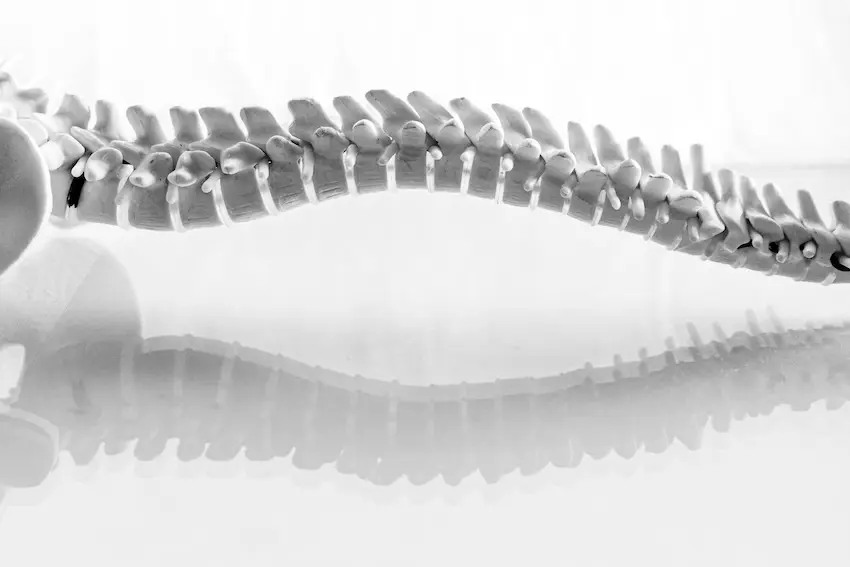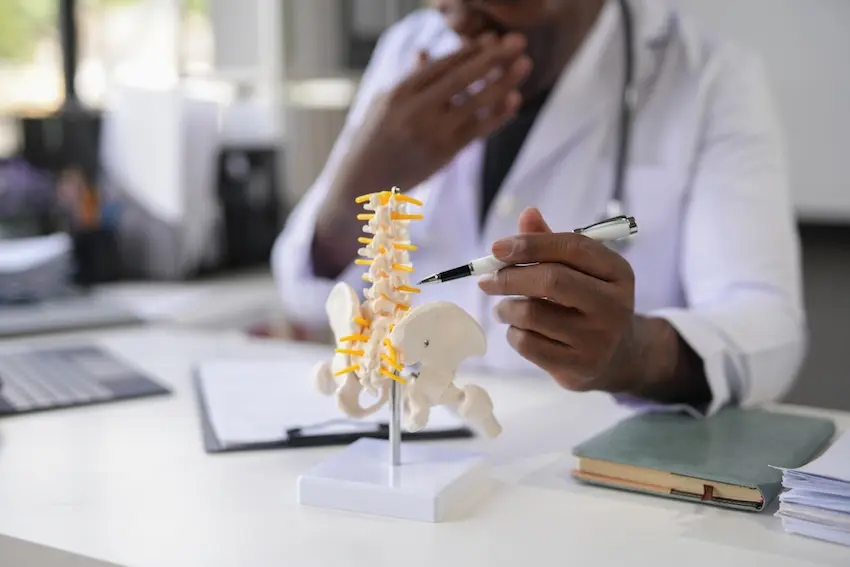Understanding Functional Limitations
Personalized Treatment to Restore Your Independence and Quality of Life
A functional limitation is the reduction in your ability to perform everyday activities, work tasks, or movements you once took for granted.
When spine or joint conditions interfere with how your body moves, these restrictions directly impact your independence, career, relationships, and overall quality of life.
At VeriSpine Joint Centers, we understand that numbers on an imaging report don’t tell your whole story. What matters most is how pain and mobility issues affect your daily reality. Our multidisciplinary team takes a comprehensive, individualized approach to identify what’s limiting you—and then develops a personalized treatment plan focused on meaningful, lasting recovery.
Our Commitment to You: We’ve helped restore function to thousands of metro Atlanta patients since 1994. Whether you’re struggling with work-related injuries, auto accident recovery, or chronic pain conditions, we’re dedicated to walking with you every step of the way toward regaining the life you deserve.
Stop accepting limited mobility as your reality—VeriSpine specializes in helping people like you regain the life you deserve.
What Functional Limitations Really Mean for Your Life
You might have received a diagnosis—herniated disc, spinal stenosis, arthritis—but what you’re experiencing goes far beyond medical terminology. You’re facing real challenges that affect everything from your morning routine to your ability to provide for your family.
Functional limitations describe the gap between what you want to do and what your body currently allows. One patient might struggle getting out of bed each morning. Another can’t lift their grandchild. Someone else faces the difficult reality that their career is at risk because sitting through an eight-hour workday has become unbearable.
These restrictions develop when musculoskeletal impairments—whether from injury, degeneration, or chronic conditions—interfere with normal body mechanics. The relationship between structural problems and actual disability varies significantly. Two people with similar MRI findings often experience vastly different levels of impairment, which is why our treatment approach focuses on your unique situation rather than simply treating test results.

Conditions Our Doctors Treat That Cause Functional Limitations
Through our decades of experience treating over 50,000 metro Atlanta patients, our specialized physicians have developed expertise in diagnosing and treating the full spectrum of spine and joint conditions that restrict daily function.
Here are the primary conditions we treat at VeriSpine Joint Centers:
Spine Conditions
Herniated and Bulging Discs
Disc material pressing on nerve roots creates radiating pain, numbness, and weakness that limit bending, lifting, prolonged sitting, and work capacity. Our interventional procedures target inflammation at the source to restore mobility.
Degenerative Disc Disease
Progressive breakdown of spinal cushions causes mechanical pain with everyday movements—tying shoes, lifting groceries, sitting through meetings. We treat this through regenerative medicine and minimally invasive interventions.
Spinal Stenosis (Lumbar & Cervical)
Canal narrowing compresses the spinal cord or nerves, creating walking limitations, leg weakness, and balance problems. Our targeted epidural injections and decompression techniques reduce neurogenic claudication symptoms.
Sciatica
Nerve compression causing shooting pain from lower back through the leg severely restricts standing tolerance, walking distance, and ability to perform physical work. We use selective nerve root blocks and physical therapy protocols for resolution.
Cervical and Lumbar Radiculopathy
Pinched nerves in the neck or lower back radiate pain into arms or legs with weakness and numbness that affect hand function, grip strength, walking ability, and occupational tasks. Our transforaminal injections provide precise relief.
Facet Joint Syndrome
Arthritic spinal joints cause localized back pain and stiffness limiting rotation and extension—affecting driving, overhead work, and prolonged standing. We treat this with facet injections and medial branch blocks.
Spondylolisthesis
Vertebral slippage creates instability, nerve compression, and mechanical pain that restricts bending, lifting, and impact activities. Our stabilization therapies and interventional treatments prevent progression.
SI Joint Dysfunction
Sacroiliac joint inflammation causes lower back and buttock pain that worsens with sitting, stair climbing, and transitional movements. We provide SI joint injections and regenerative treatments for lasting relief.
Joint Conditions
Knee Osteoarthritis
Cartilage breakdown causes pain, swelling, and stiffness that limit walking distance, stair use, standing tolerance, and physical activity. We offer viscosupplementation, steroid injections, and stem cell therapy.
Hip Arthritis and Bursitis
Joint degeneration and inflammation restrict weight-bearing, walking endurance, and leg mobility needed for daily tasks. Our intra-articular injections and regenerative approaches delay or prevent surgical needs.
Shoulder Conditions
Rotator cuff injuries, adhesive capsulitis, and arthritis limit overhead reaching, lifting capacity, and upper extremity function essential for work and self-care. We provide targeted shoulder injections and rehabilitation.
Injury-Related Conditions We Specialize In
Auto Accident Injuries
Whiplash-associated disorders, traumatic disc injuries, soft tissue damage, and post-collision pain syndromes create persistent mobility restrictions. We provide comprehensive accident injury rehabilitation with insurance expertise.
Work-Related Injuries
Repetitive strain, lifting trauma, occupational overuse, and workplace accidents cause cumulative damage threatening your career. We manage workers’ compensation cases with focused return-to-work protocols.
Sports Injuries
Acute trauma and overuse conditions in athletes require specialized treatment to restore competitive function. Our sports medicine approach combines regenerative therapies with performance-focused rehabilitation.
Chronic Pain Conditions
Failed Back Surgery Syndrome
Persistent or recurrent pain after spinal surgery limits function despite intervention. Our specialized protocols address scar tissue, adjacent segment degeneration, and nerve irritation using advanced pain management techniques.
Myofascial Pain Syndrome
Trigger points and muscle dysfunction create widespread pain patterns and movement restrictions. We treat this with trigger point injections, physical therapy, and manual techniques.
Complex Regional Pain Syndrome (CRPS)
This severe pain condition following injury causes extreme sensitivity, swelling, and progressive functional loss. Our multimodal interventional approach includes sympathetic blocks and comprehensive rehabilitation.
Comprehensive Treatment Approach: Our physicians don’t just treat your diagnosis—we address how it affects your life. Every condition listed above receives personalized treatment combining our 12+ available procedures, evidence-based physical therapy, and when appropriate, innovative regenerative medicine including stem cell therapy. With over 60 years of collective provider experience, we’ve refined protocols that consistently restore function and reduce disability across this full spectrum of conditions.

How Physical Restrictions Impact Every Aspect of Life
The true burden of functional limitations extends far beyond physical discomfort. These challenges create ripple effects across every domain of your life:
Your Career and Financial Security
When job demands exceed what your body can handle, everything becomes more difficult. Manual workers face immediate obstacles with lifting, standing, or sustained physical exertion. Office professionals struggle with prolonged sitting and computer work. The anxiety of reduced productivity, increased absences, and concerns about job security compound the physical challenges you’re already facing.
Independence and Daily Living
Activities you never thought twice about suddenly require planning, assistance, or become impossible. Getting dressed, bathing, preparing meals, and basic household tasks become exhausting efforts or require help from others. This loss of independence affects not just practical matters but your sense of identity and self-worth.
Family and Relationships
When pain and mobility issues prevent you from participating in family activities, playing with your children or grandchildren, or fulfilling household responsibilities, relationships suffer. Partners take on additional burdens. Social connections weaken as you decline invitations and withdraw from activities you once enjoyed together.
Emotional and Mental Wellbeing
Chronic restrictions take a psychological toll. Frustration, anxiety, and depression commonly develop when your body no longer allows you to live the life you want. Sleep disruption from positional pain creates fatigue that makes everything harder. The cumulative emotional weight often becomes as challenging as the physical limitations themselves.
Why Early Intervention Matters
Functional limitations rarely improve on their own. Without proper treatment, compensatory movement patterns develop, other areas of your body begin breaking down, and temporary restrictions become permanent disability. Our experience shows that patients who seek comprehensive evaluation and treatment early achieve significantly better long-term outcomes.

Our Comprehensive Evaluation Process
At VeriSpine, we take time to understand your complete picture. Our thorough assessment goes beyond reviewing test results—we want to know how your condition affects your daily life, work, and personal goals.
Detailed Medical HistoryWe review your injury or pain history, previous treatments, current medications, and how your symptoms have evolved over time.
Functional Capacity TestingWe measure what you can actually do—range of motion, strength, endurance, and tolerance for work-specific or daily activities.
Pain and Disability ScoringValidated questionnaires quantify how restrictions affect your work capacity, household tasks, social participation, and overall quality of life.
Diagnostic Imaging ReviewWe correlate MRI, CT, or X-ray findings with your clinical symptoms to identify the structural problems driving your limitations.
Goal-Centered DiscussionWe establish realistic treatment objectives based on what matters most to you—returning to work, caring for family, resuming hobbies, or simply moving without pain.
Treatment PlanningBased on all findings, we develop a personalized, evidence-based care plan designed to address both your immediate needs and long-term wellness.
Your Path to Restored Function
Our treatment philosophy emphasizes non-surgical, minimally invasive approaches that target the root cause of your limitations while supporting your body’s natural healing capacity. We’ve refined our methods over 30 years of clinical practice to deliver the most effective care possible.
Physical Therapy and Rehabilitation
Customized exercise programs strengthen supporting muscles, improve flexibility, correct movement dysfunction, and gradually rebuild your tolerance for activities. Our therapists work closely with you to ensure steady progress while staying within safe pain thresholds.
Interventional Pain Management
When conservative care needs additional support, our specialized procedures provide targeted relief. Epidural injections, facet blocks, and joint injections reduce inflammation and interrupt pain signals, creating windows where rehabilitation becomes more effective and functional gains accelerate.
Regenerative Medicine
We bring innovative therapies like stem cell treatments to our patients by employing current best practices. These advanced options support tissue healing and can provide long-lasting improvement in function for appropriate candidates.
Coordinated, Multidisciplinary Care
Complex conditions require comprehensive solutions. Our team collaborates to address physical, psychological, and functional dimensions simultaneously. This integrated approach—combining targeted interventions with rehabilitation, pain psychology when needed, and ongoing support—delivers superior outcomes compared to fragmented care.
Throughout your treatment, we remain committed to ongoing education and innovation, ensuring you benefit from the latest evidence-based advances in pain and injury care. More importantly, we stay focused on what matters most: helping you regain independence, return to meaningful activities, and reclaim your quality of life.

Frequently Asked Questions About Functional Limitations
How long does it take to recover from functional limitations caused by spine or joint injuries?
Recovery from functional limitations typically ranges from 6-12 weeks for acute injuries to 3-6 months for chronic conditions, depending on injury severity, underlying pathology, treatment compliance, and individual healing factors. Auto accident injuries and work-related trauma often show measurable improvement within 4-8 weeks of beginning interventional pain management combined with physical therapy.
Timeline variables include the extent of tissue damage, presence of nerve compression, age, overall health status, and how quickly treatment begins after symptom onset. Patients with degenerative conditions like spinal stenosis or advanced arthritis may require ongoing management rather than complete resolution, but most experience significant functional gains within the first three months of comprehensive care. At VeriSpine, we establish realistic recovery milestones during your initial evaluation based on your specific diagnosis and functional capacity assessment.
What’s the difference between functional limitations and disability for work purposes?
Functional limitations describe specific physical restrictions in performing activities (such as lifting capacity, walking endurance, or sitting tolerance), while disability refers to the broader inability to perform substantial gainful employment due to those limitations. You can have functional limitations without meeting legal disability thresholds if you can still perform modified or alternative work.
For workers’ compensation claims, functional capacity evaluations measure exact restrictions—like maximum lifting weight of 10 pounds, inability to stand longer than 20 minutes, or inability to perform overhead reaching. These objective measurements determine work restrictions and guide return-to-work planning. Social Security disability determinations require functional limitations severe enough to prevent any substantial work for at least 12 months. Insurance carriers use standardized impairment ratings that correlate specific mobility restrictions and range of motion deficits with disability percentages. Our documentation includes detailed functional assessments that support workers’ comp claims, disability applications, and occupational accommodations.
Can functional limitations from chronic pain become permanent without treatment?
Yes, untreated functional limitations frequently become permanent as deconditioning, compensatory movement patterns, muscle atrophy, and progressive joint degeneration create irreversible changes. Research shows that activity restrictions lasting beyond 6-12 months without intervention have significantly lower recovery rates due to neuroplastic pain adaptations and structural deterioration.
The cascade typically progresses as follows: initial injury causes pain and movement avoidance, leading to muscle weakness and flexibility loss. This deconditioning increases stress on adjacent joints and spine segments, accelerating degenerative changes. Neural pathways establish chronic pain patterns that persist even after tissue healing. Psychological factors like fear-avoidance behaviors further restrict activity. Eventually, what began as temporary impairment solidifies into permanent disability. Early intervention with evidence-based treatments—including physical therapy, interventional pain procedures, and regenerative medicine—interrupts this progression. Our 30 years of experience demonstrates that patients who begin comprehensive treatment within the first 3-6 months of symptom onset achieve substantially better long-term functional outcomes than those who delay care.
How do doctors measure and document functional limitations for medical records?
Physicians measure functional limitations through functional capacity evaluations, range of motion testing, strength assessments, validated disability questionnaires (like Oswestry Disability Index or WOMAC), and standardized performance tests that objectively quantify physical restrictions for medical documentation and legal purposes.
Clinical assessment protocols include goniometric measurement of joint angles to document mobility deficits, manual muscle testing graded on a 0-5 scale, timed walking tests for endurance capacity, and lifting assessments determining maximum safe weights. Functional questionnaires ask patients to rate difficulty with specific activities—dressing, bathing, walking distances, standing duration, sitting tolerance, and occupational tasks. The Oswestry scale quantifies lumbar spine disability from 0-100%, while WOMAC scores measure hip and knee impairment severity. For workplace injury documentation, formal FCEs simulate job-specific demands through 4-6 hour testing protocols that establish precise work restrictions. Our comprehensive evaluations generate detailed reports documenting baseline functional status, treatment progress, and residual limitations—critical for insurance claims, disability determinations, and return-to-work planning.
Will physical therapy alone resolve functional limitations from herniated discs or spinal stenosis?
Physical therapy effectively resolves functional limitations in 40-60% of patients with herniated discs and 30-50% with mild to moderate spinal stenosis, but severe cases or those with significant nerve compression typically require combined treatment including interventional pain management for optimal functional recovery.
Success depends on pathology severity, symptom duration, and neural involvement. Mild disc herniations with primarily mechanical pain respond well to core strengthening, postural correction, and manual therapy alone. However, large herniations causing radiculopathy or severe stenosis creating neurogenic claudication often need epidural steroid injections to reduce inflammation enough for rehabilitation to progress. The anti-inflammatory effect creates a therapeutic window where exercise tolerance improves and functional gains accelerate. At VeriSpine, our multidisciplinary approach combines targeted injections with structured physical therapy protocols. This integrated strategy typically produces superior outcomes compared to either treatment alone—reducing both pain intensity and activity restrictions while minimizing surgical intervention needs for over 80% of appropriate candidates.
What percentage of functional limitation qualifies for permanent disability benefits?
Permanent disability qualification varies by state and program, but workers’ compensation typically requires 10-25% whole-body impairment rating, while Social Security Disability demands functional limitations severe enough to prevent any substantial work—generally corresponding to 50%+ disability in multiple functional categories or inability to perform sedentary work.
Workers’ comp systems use AMA Guidelines to assign impairment percentages based on specific deficits: range of motion loss, nerve damage, surgical interventions, and residual symptoms. A 10-15% lumbar spine impairment might translate to 5-10% whole-body rating. Ratings of 25%+ typically qualify for permanent partial disability settlements. Social Security uses a different framework—requiring documentation that functional limitations prevent sitting 6+ hours, standing 2+ hours, lifting 10+ pounds, or performing basic work activities for at least 12 consecutive months. Spine conditions must show MRI evidence of nerve root compression plus objective weakness, sensory loss, or reflex changes. Our detailed functional documentation includes impairment ratings, specific work restrictions, and evidence-based assessments that support disability claims while identifying treatment options that may restore work capacity.
Can functional limitations worsen over time even with treatment?
Yes, functional limitations can progress despite treatment when underlying degenerative conditions advance, when patients don’t adhere to therapeutic recommendations, or when initial pathology was too severe for conservative management to halt deterioration. However, appropriate treatment typically slows progression significantly compared to natural disease course.
Progressive conditions like osteoarthritis, multi-level spinal stenosis, and degenerative spondylolisthesis involve structural changes that may continue despite optimal care—though treatment substantially reduces symptom severity and maintains higher functional capacity than untreated progression. Age-related degeneration, genetic factors, occupational demands, and comorbidities like diabetes or obesity accelerate functional decline. Poor treatment compliance—skipping physical therapy sessions, continuing harmful activities, or ignoring activity modifications—allows compensatory patterns and deconditioning to worsen restrictions. Importantly, progression isn’t inevitable. Our regenerative medicine approaches, including stem cell treatments, can modify disease trajectory. Regular monitoring through functional assessments allows intervention adjustments before significant decline occurs. Patients who maintain exercise programs, follow activity guidelines, and receive periodic interventional procedures typically stabilize or improve functional capacity even with progressive underlying pathology.
What types of jobs can I still perform with moderate functional limitations from back pain?
Moderate functional limitations typically allow sedentary to light-duty work with restrictions on lifting (10-20 pound maximum), limited standing/walking (under 2-3 hours daily), and frequent position changes—including desk jobs, customer service roles, administrative positions, computer-based work, light assembly, and telecommunications when proper ergonomic accommodations are implemented.
Functional capacity determines work categories: sedentary work (primarily sitting, lifting under 10 pounds), light work (occasional 20-pound lifting, standing up to 6 hours), medium work (50-pound lifting, prolonged standing), and heavy work (100+ pound lifting, intense physical demands). Moderate lumbar functional limitations typically preclude medium and heavy categories but allow accommodated light or sedentary positions. Viable occupations include data entry, call center work, reception, accounting, programming, medical coding, customer service, graphic design, writing, and supervisory roles. Workplace accommodations like sit-stand desks, ergonomic chairs, lifting assistance devices, and flexible break schedules often enable successful employment despite restrictions. Our functional capacity evaluations provide specific guidance on compatible work categories and necessary accommodations, helping patients identify viable career options during recovery or transition planning.
Does insurance cover treatment for functional limitations from auto accidents or work injuries?
Yes, auto accident functional limitations are typically covered through personal injury protection (PIP), medical payments coverage, or liability claims, while work-related limitations fall under workers’ compensation insurance that covers all necessary and reasonable treatment without requiring copays or deductibles from injured workers.
Auto insurance coverage varies by state—no-fault states provide immediate PIP benefits (typically $10,000-$50,000) covering medical treatment regardless of fault. At-fault claims access the responsible party’s liability coverage, often with higher limits. Medical payments coverage provides additional resources. Workers’ compensation operates differently—employers must cover all medically necessary treatment for work-related injuries, including physical therapy, interventional pain procedures, regenerative medicine, and even surgery when conservative approaches prove insufficient. There are no coverage limits for authorized medical care. Treatment authorization requires establishing medical necessity and demonstrating that proposed interventions will reduce functional limitations and facilitate return to work. At VeriSpine, we have extensive experience with both auto accident and workers’ compensation cases. We handle all insurance documentation, pre-authorization requirements, and medical-legal reports—ensuring your treatment proceeds without administrative barriers while you focus on recovery.

Why Choose VeriSpine Joint Centers
- Years of Excellence Since 1994
- Patients Successfully Treated
- Advanced Treatment Procedures
- Combined Years of Provider Experience
Located in metro Atlanta, we’ve built our reputation on clinical excellence combined with genuine compassion. From your first consultation through your final treatment and beyond, our experienced team is committed to your recovery. We don’t just treat conditions—we help real people overcome real challenges and return to living fully.
Take the First Step Toward Recovery
Your physical limitations are treatable, not permanent—and VeriSpine has the expertise to restore your function and independence.
You don’t have to accept limited mobility, chronic pain, or decreased independence as your new reality. Our team specializes in helping people just like you restore function and reclaim their lives through personalized, evidence-based care.
Discover the VeriSpine difference—where healing begins with understanding your unique needs and developing a treatment plan focused on your goals.
Call 678-782-7999 now or schedule your consultation online to start moving freely again—your path to healing begins today.

